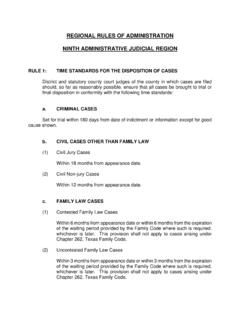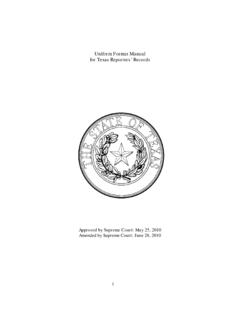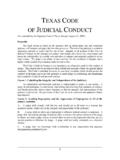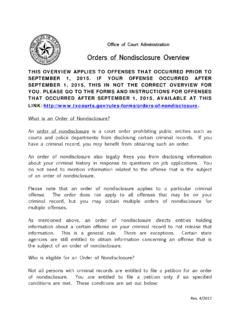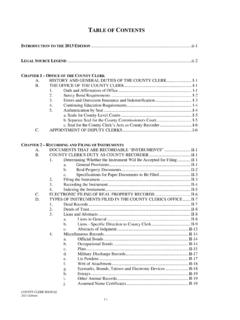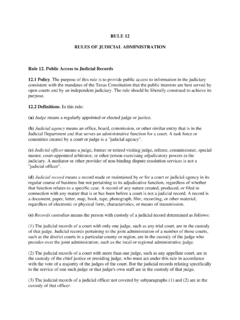Transcription of Texas Courts: A Descriptive Summary
1 1 Texas Courts: A Descriptive SummaryJones County Courthouse - AnsonPhoto courtesy of reflected on page 3, there were 3,468 elected (or appointed, in the case of most municipal judges) judicial positions in Texas as of September 1, 2013. In addition, there were more than 140 associate judges appointed to serve in district , county-level, child protection, and child support (Title IV-D) courts, as well as numerous magistrates, masters, referees and other officers supporting the judiciary. More than 315 retired and former judges were also eligible to serve for basic structure of the present court system of Texas was established by an 1891 constitutional amendment. The amendment established the Supreme court as the highest state appellate court for civil matters, and the court of Criminal Appeals, which makes the final determination in criminal matters. Today, there are also 14 courts of appeals that exercise intermediate appellate jurisdiction in civil and criminal courts are the state trial courts of general jurisdiction.
2 The geographical area served by each district court is established by the specific statute creating that court . In addition to these state courts, the Texas Constitution provides for a county court in each county, presided over by the county judge. The county judge also serves as head of the county commissioners court , the governing body of the county. To aid the constitutional county court with its judicial functions, the Legislature has established statutory county courts, generally designated as county courts at law or statutory probate courts, in the more populous counties. The Texas Constitution also authorizes not less than one nor more than 16 justices of the peace in each county. The justice courts generally have exclusive jurisdiction of civil matters when the amount in controversy does not exceed $200 and concurrent jurisdiction with the county courts when the amount in controversy exceeds $200 but does not exceed $10,000.
3 They also have jurisdiction in misdemeanor cases where punishment upon conviction may be by fine statute, the Legislature has created municipal courts in each incorporated city in the state. These courts have original jurisdiction over violations of municipal ordinances and concurrent jurisdiction with the justice courts over misdemeanor state law violations, limited to the geographical confines of the municipality. Municipal courts also have civil jurisdiction limited to a few specific types of in the justice courts and most municipal courts are not of record, and appeals therefrom are by new trial ( trial de novo ) to the county court , except in certain counties, where the appeal is to a county court at law or to a district court . When an appeal is by trial de novo, the case is tried again in the higher court , just as if the original trial had not of the various levels of courts is established by constitutional provision and by statute.
4 Statutory jurisdiction is established by general statutes providing jurisdiction for all courts on a particular level, as well as by the statutes establishing individual courts. Thus, to determine the jurisdiction of a particular court , recourse must be had first to the Constitution, second to the general statutes establishing jurisdiction for that level of court , third to the specific statute authorizing the establishment of the particular court in question, fourth to statutes creating other courts in the same county (whose jurisdictional provisions may affect the court in question), and fifth to statutes dealing with specific subject matters (such as the Family Code, which requires, for example, that judges who are lawyers hear appeals from cases heard by non-lawyer judges in juvenile cases).3 court STRUCTURE OF TEXASSEPTEMBER 1, 2013 Criminal AppealsCivil Appeals-- Jurisdiction --Supreme court (1 court -- 9 Justices)Municipal Courts2(927 Cities -- 1,586 Judges) court of Criminal Appeals(1 court -- 9 Judges)Justice Courts1(817 Courts -- 817 Judges)-- Statewide Jurisdiction ---- Jurisdiction --Appeals ofDeath Sentences-- Jurisdiction --Final appellate jurisdiction in civiland juvenile of Appeals(14 Courts -- 80 Justices) district Courts(457 Courts -- 457 Judges)County-Level Courts(510 Courts -- 510 Judges)-- Regional Jurisdiction ---- Jurisdiction --(359 Districts Containing One County and 98 Districts Containing More than One County)(One court in Each County)(Established in 88 Countiesplus 1 Multi-county court )(Established in 10 Counties)(Established in Precincts Within Each County)-- Jurisdiction ---- Jurisdiction ---- Jurisdiction --Constitutional County Courts (254)Statutory County Courts (238)
5 Statutory Probate Courts (18)Intermediate appeals from trial courtsin their respective courts of civil, criminal, original andappellate actions prescribed bylaw for constitutional addition, jurisdiction overcivil matters up to $200,000(some courts may have highermaximum jurisdiction amount).Limited primarilyto probate appellate jurisdiction incriminal HighestAppellate CourtsState IntermediateAppellate CourtsState Trial Courtsof General andSpecial JurisdictionCounty Trial Courts ofLimited JurisdictionLocal Trial Courts ofLimited Jurisdiction Original jurisdiction in civil actions over $200,divorce,title to land, contested elections. Original jurisdiction in felony criminal district courts are designated criminal district courts; some others are directed to give preference to certain specialized jurisdiction in civil actionsbetween $200 and $10, (contested matters may be transfered to district court ).Exclusive original jurisdiction overmisdemeanors with fines greaterthan $500 or jail de novo from lower courtsor on the record from municipalcourts of misdemeanors punishable by fine only (no confinement).
6 Exclusive original jurisdiction over municipal ordinance criminal cases. Limited civil Civil actions of not more than $10, misdemeanors punishable by fine only (no confinement).Magistrate Statewide Jurisdiction -- 1. All justice courts and most municipal courts are not courts of record. Appeals from these courts are by trial de novo in the county-level courts, and in some instances in the district Some municipal courts are courts of record -- appeals from those courts are taken on the record to the county-level courts. As of September 2013, 151 courts indicated that they were a court of record; a list is posted at . 3. An offense that arises under a municipal ordinance is punishable by a fine not to exceed: (1) $2,000 for ordinances that govern fire safety, zoning, and public health or (2) $500 for all Revenue$190,207, General Revenue$41,664,199 Funds$88,205,645 Funds$1,800,000 of the Texas Judicial BranchThe State provides funding for salaries and operating costs of the Supreme court , court of Criminal Appeals and 14 intermediate appellate courts.
7 The State funds a base salary for district judges and salary supplements for certain constitutional and statutory county court judges, as well as salaries, salary supplements, retirement and other payroll-related benefits for certain prosecutors. The State also pays for or supplements some other expenses of the judicial branch, including juror pay, basic civil legal services, indigent defense, and special prosecution units. Most counties supplement the base salary of judges of the intermediate appellate courts and district courts. Counties pay the operating costs of district courts, as well as the base salary of judges, full salaries of other staff, and operating costs for constitutional county courts, county courts at law, and justice courts. Cities finance all costs related to the operation of municipal courts, including judges salaries. In FY 2013, original state appropriations for the Texas judicial system increased by percent from the previous fiscal year and accounted for approximately percent of all state appropriations ($321,877,770 of the $79,184,769,459 appro-priated from all funds in FY 2013).
8 Nearly 60 percent of the financing for the judicial system came from General Revenue. Another percent came from dedicated General Revenue funds, such as the Fair Defense Account and the Judicial and court Personnel Training Fund, while the remaining percent came from other funds, including the Judicial Fund and federal funds. Excluding grant funds administered by judicial agencies and funds appropriated for operating the statewide e-filing system, approximately $254 million was appropriated for state judicial branch operating costs. Personnel accounted for approximately 93 percent of operating costs. Much of the remaining 7 percent was dedicated to court information technology infrastructure, routine travel for 64 specialty courts and other field staff, contracts for investigator services for the Office of Capital Writs, and publications purchased by the State Law Library for the for district judges accounted for percent of appropriations for the judicial system, and judicial retirement and benefits comprised another Judicial Branch Funding Sources FY 2013 Appropriations for Operating Costs for the State Judicial Branch FY 2013 Personnel and Employee Benefits $235,334,349 Operating Costs $18,591,629 : Does not include statewide e-filing or grant funds administered by judicial Judge Salaries $57,962, Retirement and Benefits $31,634,853 $232,204, district Judge Compensation as Percentage of Total State Appropriations for the State Judicial BranchNote: Other includes salaries of appellate judges.
9 Data on judges salaries was not available separate from each court s overall $ $ $ $ $ $ $ $ $ $ $ $ $ $ $ $ $ $ $ $ $ $ $ $ $ Supreme court ProgramsPublic Integrity UnitSpecial Prosecution UnitCourt of Criminal AppealsVisiting JudgesOtherCounty Attorney SupplementSupreme CourtJudicial & court Personnel TrainingJuror PayState Employee Retirement & BenefitsCounty Judge Salary SupplementBasic Civil Legal ServicesDistrict AttorneysJudicial Retirement & Benefits14 Courts of AppealsJudicial AgenciesDistrict JudgesMillionsState Judicial Branch Appropriations, FY 2013 Notes: 1. Visiting Judges includes salaries and per diem expenses. 2. Other includes Social Security and Benefit Replacement Pay and lease payments. 3. Judicial Agencies include the Office of court Administration, Texas Judicial Council, Office of the State Prosecuting Attorney, Office of Capital Writs, State Law Library, and State Commission on Judicial Conduct.
10 Appropriations for Judicial Agencies include approximately $ million in interagency contracts. 4. district Judges includes salaries, travel, and local administrative judge salary Structure and FunctionAppellate CourtsThe appellate courts of the Texas Judicial System are: the (1) Supreme court , the highest state appellate court for civil and juvenile cases; (2) court of Criminal Appeals, the highest state appellate court for criminal cases; and (3) 14 courts of appeals, the intermediate appellate courts for civil and criminal appeals from the trial courts do not try cases, have juries, or hear witnesses. Rather, they review actions and decisions of the lower courts on questions of law or allegations of procedural error. In carrying out this review, the appellate courts are usually restricted to the evidence and exhibits presented in the trial Supreme court The Supreme court of Texas was first established in 1836 by the Constitution of the Republic of Texas , which vested the judicial power of the Republic in.
